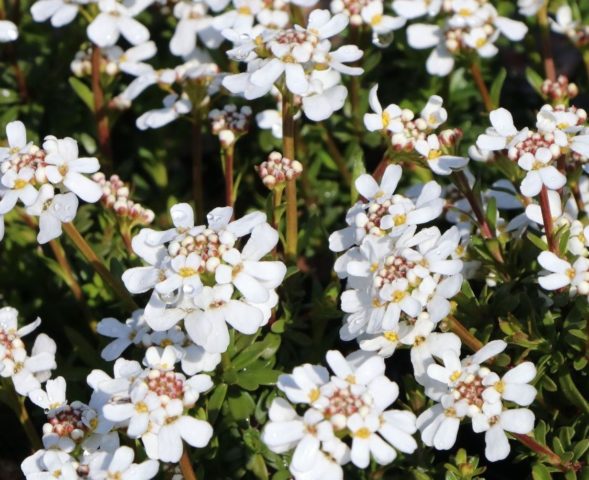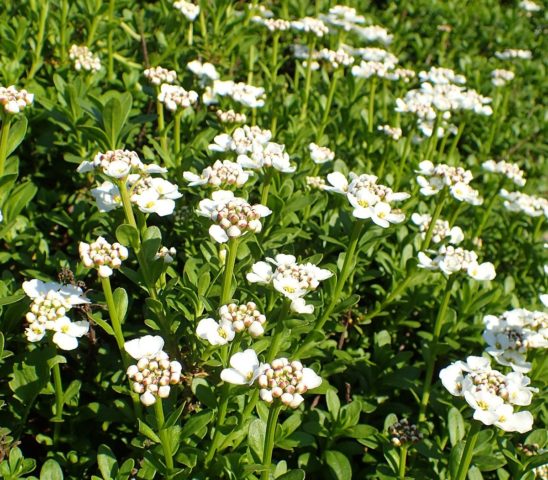Content
Looking at a photo of Iberis in a flower bed, I want to admire the charm of this plant. It is not only very beautiful, but also widely used in landscape design. Its white, pink, lilac, lilac flowers are an integral part of the design of gardens, alpine slides, tubs.
Botanical description of Iberis
Iberis (Latin Iberis), also Iberian, is a herb belonging to the Brassicaceae family of the order Brassicales. Other well-known names are stennik, peppercorn, variegated. Most often, this plant is found in the mountains of Anatolia and the Caucasus, in the south of Ukraine, in the Crimea, in the lowlands of the Don. The genus Iberis includes over 30 different species that differ significantly from each other: annuals and perennials, thermophilic and frost-resistant, herbaceous and shrubs.
What does Iberis look like?
This genus of plants is characterized by the following external attributes:
- root - pivotal;
- creeping or erect stems;
- leaves are simple, dark green with a tint;
- flowers - up to 1 cm in diameter, form umbellate inflorescences, which is uncharacteristic for Cabbage;
- the color of the petals is white, pink, purple, lilac or red;
- corollas are zygomorphic;
- stamens are simple, honey glands are located nearby;
- sepals spaced apart, not saccular;
- fruits - bivalve pods in the form of an oval or circle, flattened on the sides, with a narrow septum, at the top - a deep notch;
- each nest contains 1 hanging ovule;
- the cotyledons are flat, the embryo is located on the side of them.
When and how it blooms
Iberis bloom begins in May or August and lasts up to 2 months. It is accompanied by lush, abundant shoots: sometimes there are so many flowers that leaves are not visible behind them. Annual Iberises bloom longer than perennials. Almost all species have nice-smelling, fragrant flowers.
Good germination is maintained for 3-4 years after harvest. Reproduction takes place through seeds, cuttings and dividing the bush.
What are the differences between Alyssum and Iberis
Burachok or alissum is the closest relative of Iberis. They are very similar in appearance, and the smell of flowers is almost identical. People often use these two plants together when planting their beds, along with lyatrice and badan. The differences between them are as follows:
- Alyssum leaves are endowed with a grayish color, and not dark green, like the Iberian.
- Since ancient times, alyssum has been known for its healing properties: they resort to its help for hernias, urolithiasis, and bites. Of the Iberis, only varieties of the umbrella are used for medical purposes.
- The native places of growth of alyssum are the Mediterranean region and, in particular, the coast of the Bay of Biscay.
- Alyssum blooms in frost-free areas can continue all year round.
Types and varieties of Iberis
There are many common types of annual and perennial Iberis, with photos and descriptions of varieties. In total, there are currently about 40 plant species. Among annuals, gardeners usually cultivate only 2 species - umbrella and bitter.
Umbrella
Amazing with its beauty Iberis with bright purple flowers reaches a height of up to half a meter. This species has been cultivated since the 16th century.Popular varieties are shown in the photo.
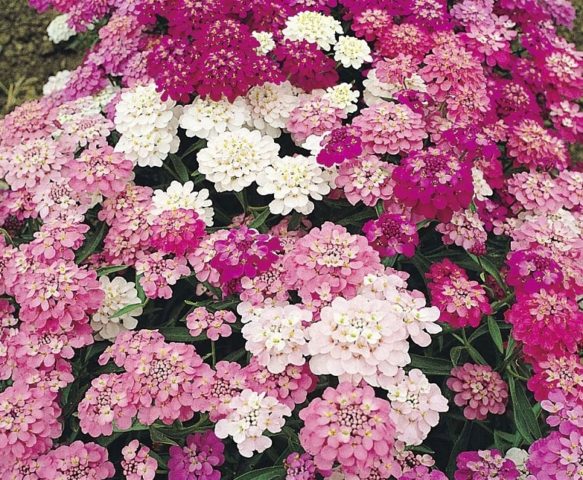
Fair Mixture - a combination of seeds with different colors looks good
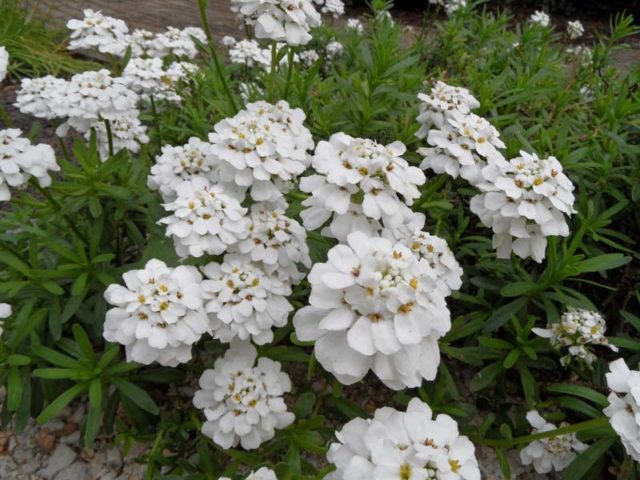
Albida - 30 cm globular bush with dense buds of small white flowers

Dunnetti - A characteristic feature of this cultivar is its purple, umbrella-shaped inflorescences
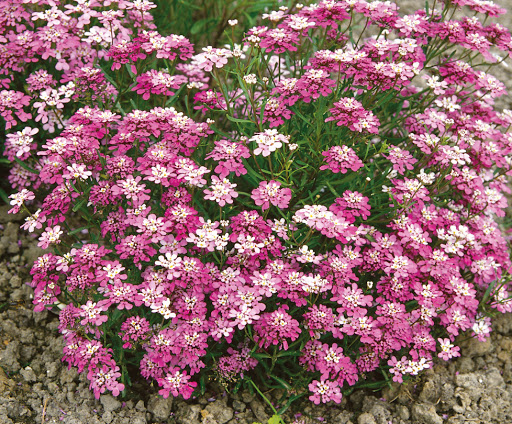
Tourmaline - has dense pink and purple flowers
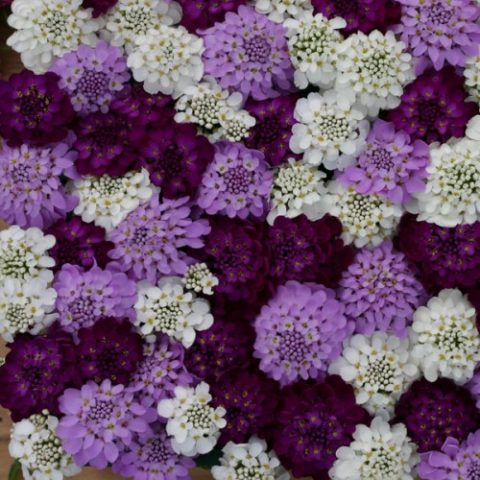
Confetti - the plant loves the sun, stretches up to 30-35 cm, flowers have different colors - from white to scarlet

Collage - another mix of colors, this time - white, lilac and dark purple
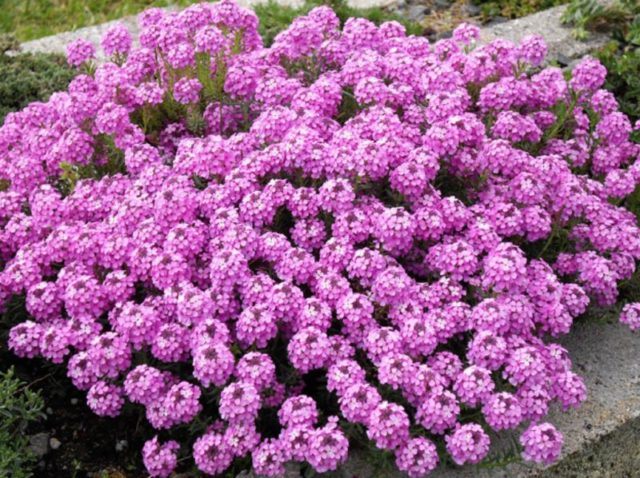
Pink Dream - Iberis with amazingly beautiful and fragrant bright pink flowers, a true decoration of any garden
Another 2 well-known varieties of this type of Iberis are Red Rash with red and purple flowers and Pomegranate Ice (the combination of white and red-scarlet inflorescences creates a likeness of pomegranate seeds mixed with ice cubes).
The umbrella Iberis Iceberg deserves special attention. It is a lovely plant with fragrant white flowers, 30-35 cm tall.
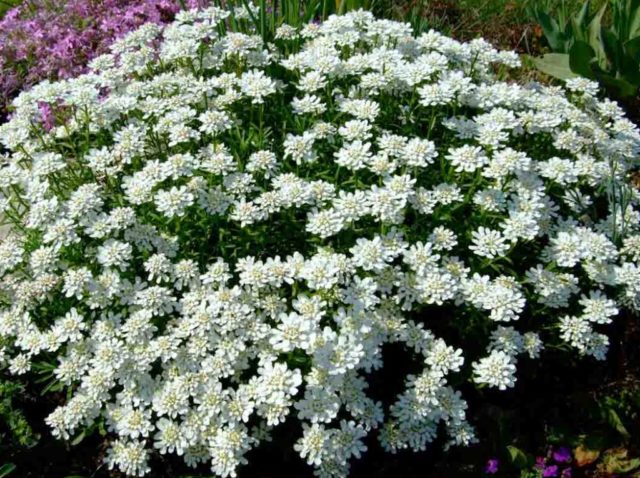
The iceberg blooms at the very end of spring and serves as a good honey plant
Bitter
This annual is characterized by branching stems and white or lavender flowers. There are many popular varieties.

Tom Tumb is a very short Iberis (up to 20 cm) with white flowers

Weiss Riesen - looks almost the same, but can grow up to 30 cm in height

Hyacintenblutige Riesen - a variety with a delicate lilac color of flowers, 35 cm high
Hyacinth-flowered
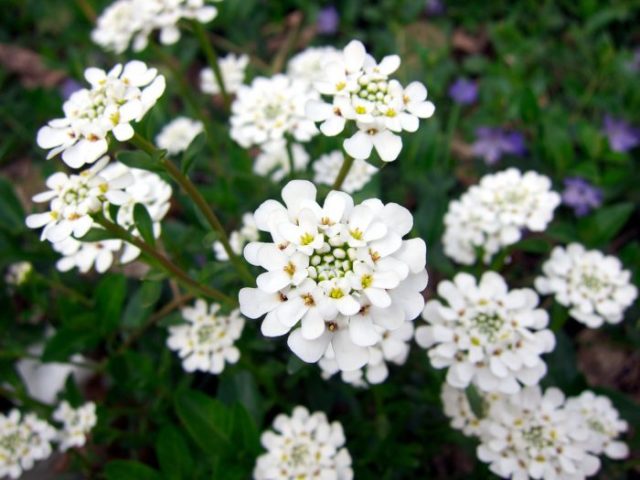
The Giant Hyacinth Flowered variety of bitter Iberis won the special love of gardeners
Representatives of this species are endowed with beautiful white inflorescences that have an external resemblance to hyacinths.
Another type of hyacinth Iberis is Express.
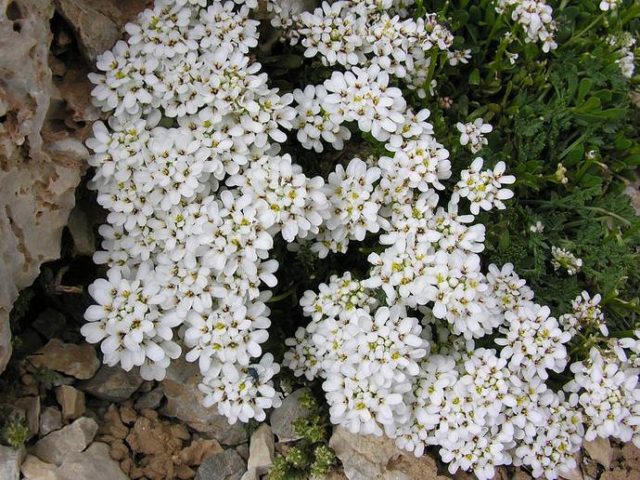
Express bushes grow tall (up to 35 cm) and enchant with beautiful white flowers
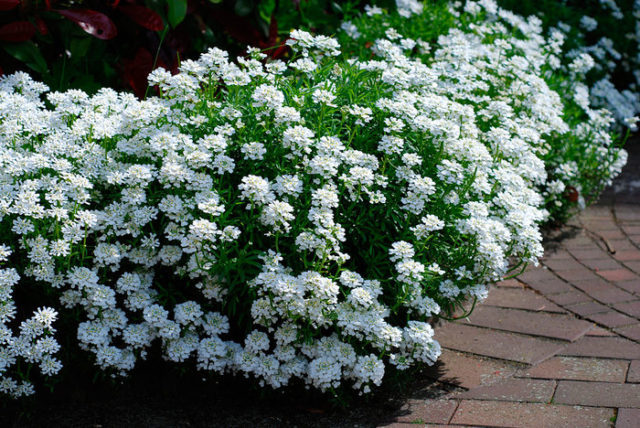
Hyacinth-flowered Iberis Empress is a common decorative variety, characterized by dense green curtains with snow-white flowers
Unlike annuals, there are many more species for cultivation among perennial plants.
Iberis Gibraltar (Gibraltar)
This is one of the most famous and beloved species among the people. Gibraltar Iberis, aka Chameleon, is a semi-evergreen plant with small pink flowers on the bushes. It is extremely unstable to winter conditions, and, as a rule, dries up in the second winter. Because of this, this type of Iberis is closer, rather, to biennials. The height of the bush is 25-30 cm, diameter is up to 40 cm. And it is called Chameleon because of the tendency of flowers to gradually change their color range.
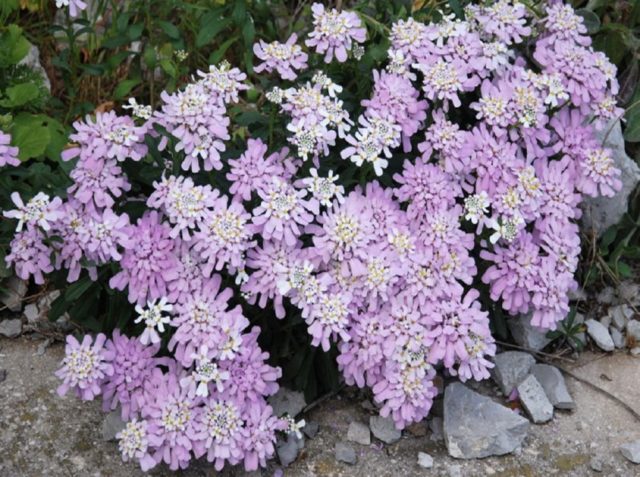
Gibraltar Candytaft is an amazingly beautiful shrub with lilac flowers that turn snow-white over time
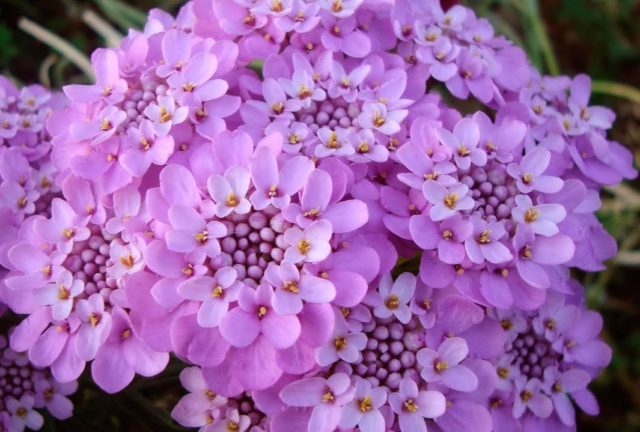
Alexandrite is a fast-growing Gibraltar Iberis with delicate purple blossoms
Another variety of the Gibraltar Iberian Sweetcandy, with white or red flowers, is usually grown on borders.
Crimean
Iberis Simplex is a perennial 5-10 cm high with gray-green leaves. Its buds are purple, and the flowers after opening are white.

Iberis Crimean grows on mountain slopes under continuous exposure to sunlight
Evergreen
Iberis Sempervirens (evergreen) is a perennial shrub up to 40 cm in height, originating from Anatolia. White flowers form umbrella-shaped inflorescences, and the leaves remain green throughout the year - hence the name of this species. Iberis evergreen is optimal for growing in pots, tubs and flower beds. Blooms profusely in early summer for a month, sometimes it repeats again in late summer.

Dana - a densely flowering 15-centimeter bush

Snowflake (Snow flakes) - variety with narrow leaves and flowers of a milky white shade
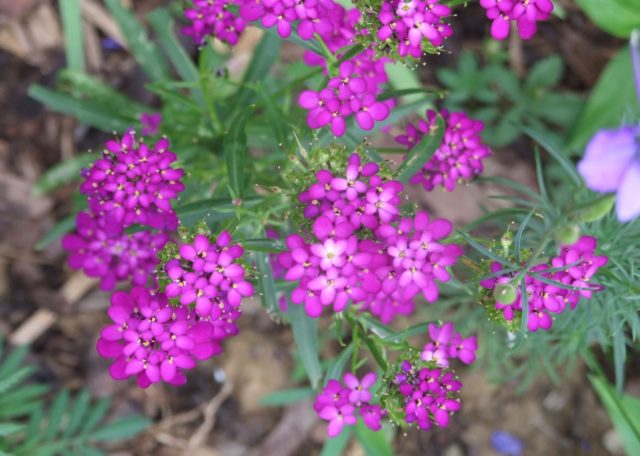
Lapis lazuli - Iberis with pink and purple inflorescences
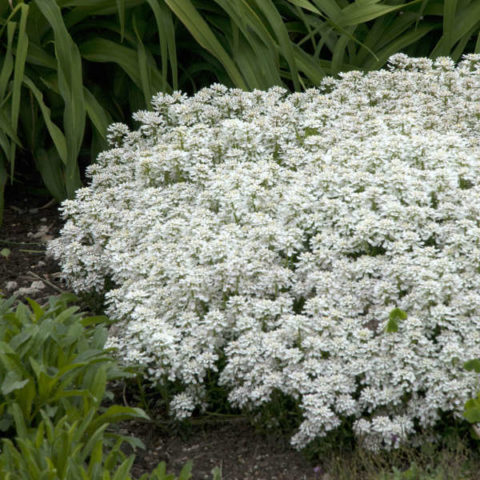
Semi-shrub 15 cm high, resembling a carpet, with white and slightly bluish flowers
Also very popular in gardening are:
- Appen-Etz - tall (up to 35 cm) plant with white inflorescences;
- Little Gem is a lush bush up to 0.5 m in diameter, with white flowers and evergreen emerald leaves in the shape of a semicircle;
- Findel is a branched bush 20-25 cm high, blooms quickly, but fades away just as quickly;
- Whiteout is a charming snow-white perennial;
- Climax - This bush forms thickets, similar to carpets - with thick leaves and an abundance of white flowers.
Rocky
This species grows on the rocky landscapes of southern Europe, from the Pyrenees to Asia Minor.

The flowers of evergreen Iberis in the flowerbed resemble a snowdrift of dense snow that covers the stems with leaves
This short shrub blooms in April-May. The most famous variety of this species is Pygmy, a bush no higher than 10 cm with umbellate inflorescences of white flowers.
Iberis in landscape design
People who care about the aesthetic beauty of their garden or flower bed often resort to using Iberis in their decor. Gardeners appreciate the plant for its multicolor and pleasant aroma, and these qualities are especially pronounced when decorating alpine slides and flower pots.
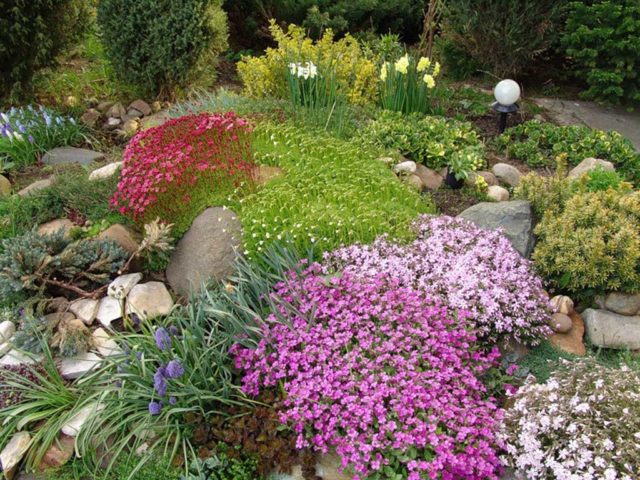
Iberis is an essential element in garden design
Iberian is a plant that is unpretentious to care for during the germination period: you do not need to often fertilize and water the soil, it is enough to thin out the seedlings and remove wilted inflorescences. This is another advantage of its use in the decor of garden areas. In addition to alpine slides, Iberis will organically look in the fringing of lawns, on curbs and paths.
Application in other fields
The varieties of umbrella Iberis Collage, Confetti and Pomegranate Ice, thanks to their richness of colors, are used as an element of bridal wedding bouquets. In general, the umbrella is the only species that is used for medicinal purposes. Their preventive properties will be effective:
- with problems with the work of the gastrointestinal tract and liver;
- in violation of blood circulation processes;
- with female diseases;
- in people with joint diseases;
- with oncology.
Conclusion
Photos of Iberis in a flower bed evoke genuine aesthetic pleasure every time. There are almost 40 species of this plant, all of them are actively used in landscape design, when decorating alpine slides, decorating flower pots and borders. The particular advantage of Iberis is that it does not require much maintenance as it grows.
